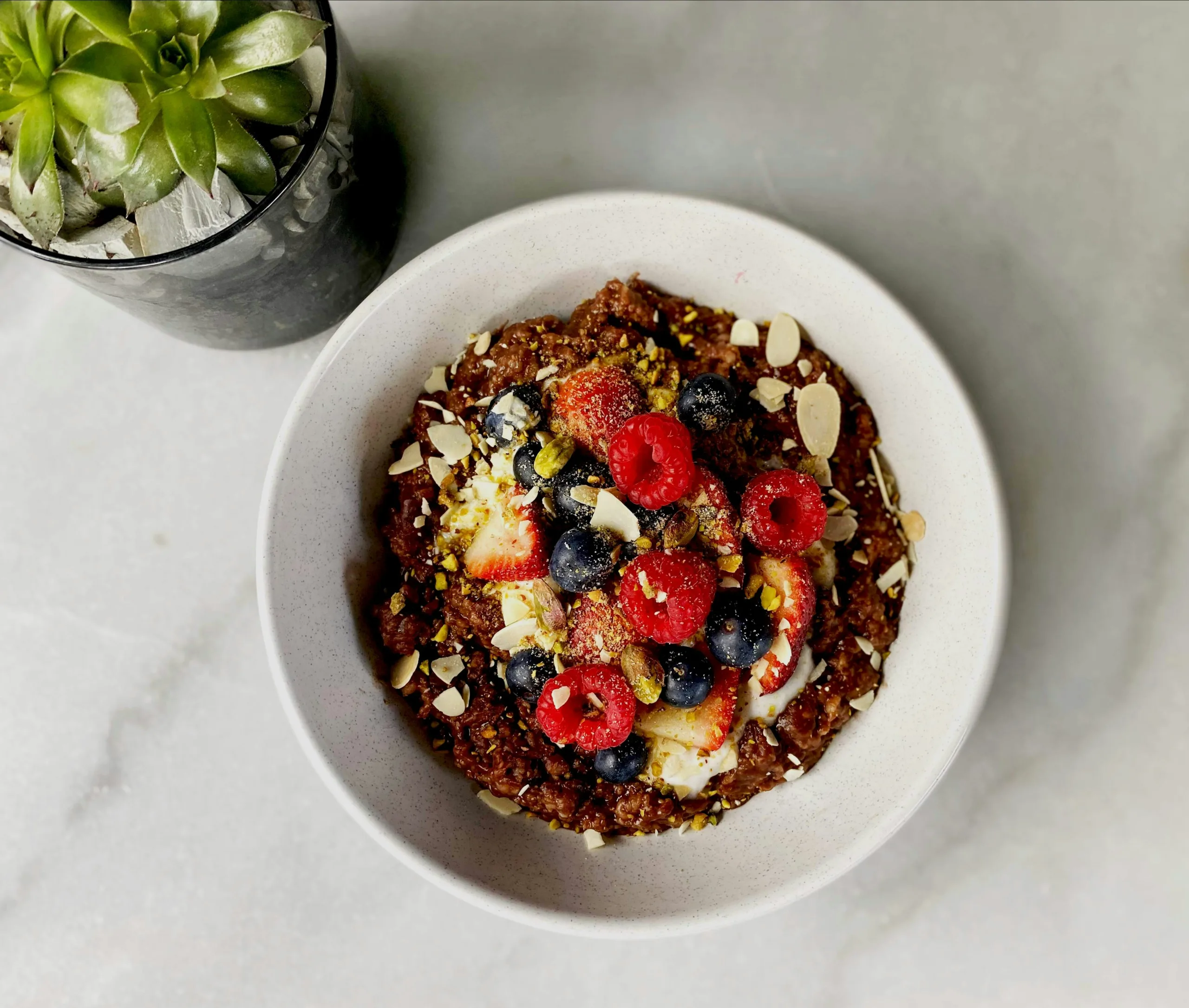By April Dupee
Wellness became mainstream over the last ten years. Thanks to increasing rates of chronic diseases and mental health conditions, Americans are turning to the health and wellness industry to address these issues like never before. We want more transparency in our food system, cleaner ingredients in our beauty products, and more efficient ways to cook healthy and exercise harder.
RELATED: The 5-Minute Workout You Can Do Anywhere
We know this because we live it. Founded by Keri Glassman, RD, and backed by countless other experts across health disciplines, Nutritious Life has led the wellness conversation for almost two decades. Let’s take a look at the biggest trends of the last ten years, plus what we can expect of wellness in the years to come.
2011: Fast-Casual Dining Takes Off

Whether you’re headed out on your lunch break or grabbing dinner on your way home from work, there’s a good chance you’ll be stopping at one of the many fast-casual restaurants now lining city streets and shopping centers.
Sweetgreen, Chipotle, Cava, Dig Inn—these convenient fast-casual eateries meet the needs of a busy yet health-conscious nation. According to market research provider Euromonitor International, sales for fast-casual restaurants grew between 10 and 11 percent annually from 2011 to 2016, making it the fastest-growing food-service segment worldwide. With quick, inexpensive and innovative meals, fast-casual dining has transformed the way Americans eat by making healthy eating accessible and attainable.
(Photo: Shutterstock)
2012: All Hail Kale (And Other Hero Ingredients)

Bon Appetite named 2012 ‘The Year of Kale’ and Time Magazine listed kale as one of the top 10 food trends of the year. Beyoncé, one of the biggest figures in pop culture, would even wear a ‘Kale’ sweatshirt in her music video a couple of years later.
Kale’s popularity hailed a new era in which veggies can be cool and hero ingredients are touted for their ability to boost health. Cauliflower can now be found in pizza and chips, and images of avocados cover our social media feeds and apparel. From ancient grains like quinoa to spices like turmeric, consumers have thrust nutrient-dense foods into the limelight and on to restaurant menus, food blogs, and food product labels.
(Photo: Shutterstock)
2013: The Boutique Fitness Boom

While boutique fitness studios like SoulCycle and Barry’s Bootcamp have been around since the early 2000s, it wasn’t until 2013 that community-centered exercise was brought to the masses with the launch of ClassPass. The app helped people discover new classes, with boutique fitness membership increasing by 70 percent from 2012 to 2017, according to International Health, Racquet, and Sportsclub Association. From here, workouts changed from a to-do to a lifestyle, complete with the athleisure to match.
(Photo: Shutterstock)
2014: Keep it Clean

Clean labeling went from a niche trend to a standard across the food industry in 2014, thanks to consumers demanding simple ingredient lists and fewer artificial ingredients. According to Innova Market Insights, an increasing number of companies began using natural sweeteners, colors, and thickeners in their products, with 20 percent of US products leveraging a clean label in 2014. This was also the same year the FDA announced it would revamp the requirements for the nutrition facts label, including added sugars. This desire for more transparency and healthier ingredients would continue to rise and can now be seen in beauty products and skincare.
(Photo: Shutterstock)
2015: Wellness Meets Instagram

The rise of food bloggers and wellness influencers put healthy-eating and fitness inspo at your fingertips. In 2015, Yoga with Adriene, a YouTube yoga community of currently 5.5 million viewers, was one of the top trending exercises on Google and healthy food blogger Ella Woodward of Deliciously Ella published her first cookbook. While there have been some negative side-effects of this social media wellness shift (for example, the spread of dangerous fad diets and filtered, unattainable health standards), there’s no denying social media has helped make wellness mainstream.
(Photo: Shutterstock)
2016: Don’t Forget About Self-Care

Scroll through Instagram and you will likely see face masks, bubble baths, cooking, and yoga all being done in the name of #selfcare (which has been hashtagged 22 million times to date). At Nutritious Life, we’ve always said that it’s important to #NurtureYourself, but the idea that taking care of your body and mind is not a luxury, but rather a necessity has really taken hold in an era of constant hustle and anxiety. The self-care movement has also coincided with the growth of meditation and mindfulness, with apps like Headspace increasing in popularity and gyms like Equinox incorporating meditation into exercise classes.
(Photo: Shutterstock)
2017: Go with Your Gut

Have you been sipping on some kombucha recently? This fermented beverage—and other fermented foods like kefir, kimchi, and miso—have sky-rocketed into popularity with sales surging 37.4 percent in 2017. Research reveals that gut microbiota plays a bigger role in our health than we once thought. We’ve learned that these good-for-you bugs may influence everything from obesity to immunity to mental health. Expect gut health to become an increasingly important part of wellness.
RELATED: The Gut-Brain Connection and How it Impacts Your Health
(Photo: Shutterstock)
2018: It’s Personal

Gone are the days of one-size-fits-all health recommendations. In an age of tailored Netflix suggestions and hand-picked meal delivery kits, we can expect our health recommendations to be personalized too. Between fad diets that fail and nutrition confusion, consumers have turned to personalized nutrition and wellness for advice that works. Advancements in epigenetics and technology have enabled companies like Habit and DayTwo to offer health advice based on your DNA or microbiome. TBD if these new developments will actually improve your health, but with a projected market growth of $11.5 billion by 2025, we can expect personalized wellness to explode in the next decade.
(Photo: Shutterstock)
2019: Plant-Based Everything

When fast-food chains start selling the Impossible Burger and Beyond Meat, you know plant-based diets have gone mainstream. With growing environmental and health concerns, lots of people are reducing their intake of animal products as a way to address these issues. But it doesn’t just stop at faux meats. Grocery aisles are now lined with plant-based milks, yogurts, and cheeses. Alternative animal products are here to stay.
(Photo: Shutterstock)
What’s Next?

It seems like every year there were new diets, new workouts, new products, and new headlines. But now that we’ve welcomed wellness into our lives, we can expect the next decade to focus on slowing down and keeping wellness stress-free. Think: wellness retreats and opportunities to disconnect, exercises that fit into our daily activities rather than full hour-long sweat sessions, and an emphasis on recovery training.
RELATED: Find the Best Massage Gun for Your Muscle Recovery Needs
The wellness world also has more career opportunities than ever. With more people becoming trainers and dietitians, people are looking to advance their understanding of the human body for an edge in the job market and to cut through the noise in a crowded space. (Want to jumpstart your health and wellness career? Sign up for the Nutritious Life Studio today!)
Plant-based diets will continue to rise as the connection between diet and the environment continue to grow. Sustainability efforts in the dairy industry will have a plant-based, dairy-enhanced diet becoming the eating plan to look out for in 2020. Get ready for more plant-based meats like fish and chicken to start hitting the shelves, and sustainability in all products—plant-based or not—to become mainstream.
Advancements in technology will bring personalized wellness to the forefront and provide new health tech for tracking our wellness. Expect companies like Peloton to grow in popularity as people seek community-based fitness in the comfort of their own homes. The wellness industry is just getting started and we can’t wait to see what’s to come in this new decade.
(Photo: Shutterstock)





























